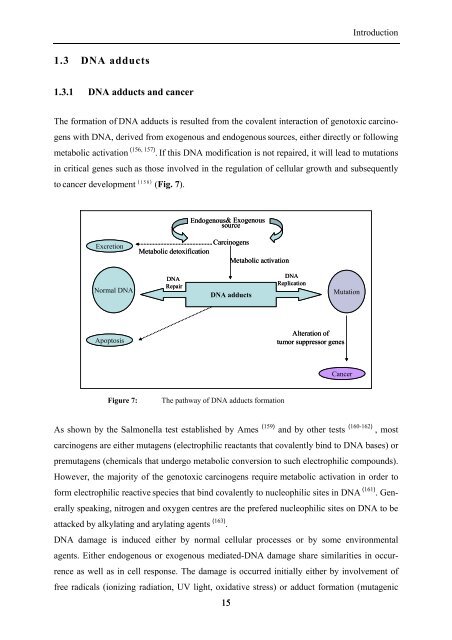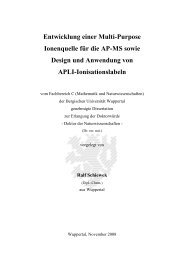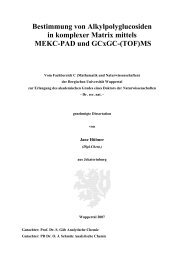The Influence of Oxidative Stress, Carcinogens and Cloning on DNA ...
The Influence of Oxidative Stress, Carcinogens and Cloning on DNA ...
The Influence of Oxidative Stress, Carcinogens and Cloning on DNA ...
You also want an ePaper? Increase the reach of your titles
YUMPU automatically turns print PDFs into web optimized ePapers that Google loves.
1.3 <strong>DNA</strong> adducts<br />
1.3.1 <strong>DNA</strong> adducts <str<strong>on</strong>g>and</str<strong>on</strong>g> cancer<br />
15<br />
Introducti<strong>on</strong><br />
<str<strong>on</strong>g>The</str<strong>on</strong>g> formati<strong>on</strong> <str<strong>on</strong>g>of</str<strong>on</strong>g> <strong>DNA</strong> adducts is resulted from the covalent interacti<strong>on</strong> <str<strong>on</strong>g>of</str<strong>on</strong>g> genotoxic carcinogens<br />
with <strong>DNA</strong>, derived from exogenous <str<strong>on</strong>g>and</str<strong>on</strong>g> endogenous sources, either directly or following<br />
metabolic activati<strong>on</strong> (156, 157) . If this <strong>DNA</strong> modificati<strong>on</strong> is not repaired, it will lead to mutati<strong>on</strong>s<br />
in critical genes such as those involved in the regulati<strong>on</strong> <str<strong>on</strong>g>of</str<strong>on</strong>g> cellular growth <str<strong>on</strong>g>and</str<strong>on</strong>g> subsequently<br />
to cancer development ( 158) (Fig. 7).<br />
Excreti<strong>on</strong><br />
Normal <strong>DNA</strong><br />
Apoptosis<br />
<strong>DNA</strong><br />
Repair<br />
Endogenous& Endogenous& Exogenous<br />
source<br />
<str<strong>on</strong>g>Carcinogens</str<strong>on</strong>g><br />
Metabolic detoxificati<strong>on</strong><br />
Metabolic activati<strong>on</strong><br />
<strong>DNA</strong> adducts<br />
Figure 7: <str<strong>on</strong>g>The</str<strong>on</strong>g> pathway <str<strong>on</strong>g>of</str<strong>on</strong>g> <strong>DNA</strong> adducts formati<strong>on</strong><br />
<strong>DNA</strong><br />
Replicati<strong>on</strong><br />
Alterati<strong>on</strong> <str<strong>on</strong>g>of</str<strong>on</strong>g><br />
tumor suppressor genes<br />
Mutati<strong>on</strong><br />
Cancer<br />
As shown by the Salm<strong>on</strong>ella test established by Ames (159) <str<strong>on</strong>g>and</str<strong>on</strong>g> by other tests (160-162) , most<br />
carcinogens are either mutagens (electrophilic reactants that covalently bind to <strong>DNA</strong> bases) or<br />
premutagens (chemicals that undergo metabolic c<strong>on</strong>versi<strong>on</strong> to such electrophilic compounds).<br />
However, the majority <str<strong>on</strong>g>of</str<strong>on</strong>g> the genotoxic carcinogens require metabolic activati<strong>on</strong> in order to<br />
form electrophilic reactive species that bind covalently to nucleophilic sites in <strong>DNA</strong> (161) . Generally<br />
speaking, nitrogen <str<strong>on</strong>g>and</str<strong>on</strong>g> oxygen centres are the prefered nucleophilic sites <strong>on</strong> <strong>DNA</strong> to be<br />
attacked by alkylating <str<strong>on</strong>g>and</str<strong>on</strong>g> arylating agents (163) .<br />
<strong>DNA</strong> damage is induced either by normal cellular processes or by some envir<strong>on</strong>mental<br />
agents. Either endogenous or exogenous mediated-<strong>DNA</strong> damage share similarities in occurrence<br />
as well as in cell resp<strong>on</strong>se. <str<strong>on</strong>g>The</str<strong>on</strong>g> damage is occurred initially either by involvement <str<strong>on</strong>g>of</str<strong>on</strong>g><br />
free radicals (i<strong>on</strong>izing radiati<strong>on</strong>, UV light, oxidative stress) or adduct formati<strong>on</strong> (mutagenic




